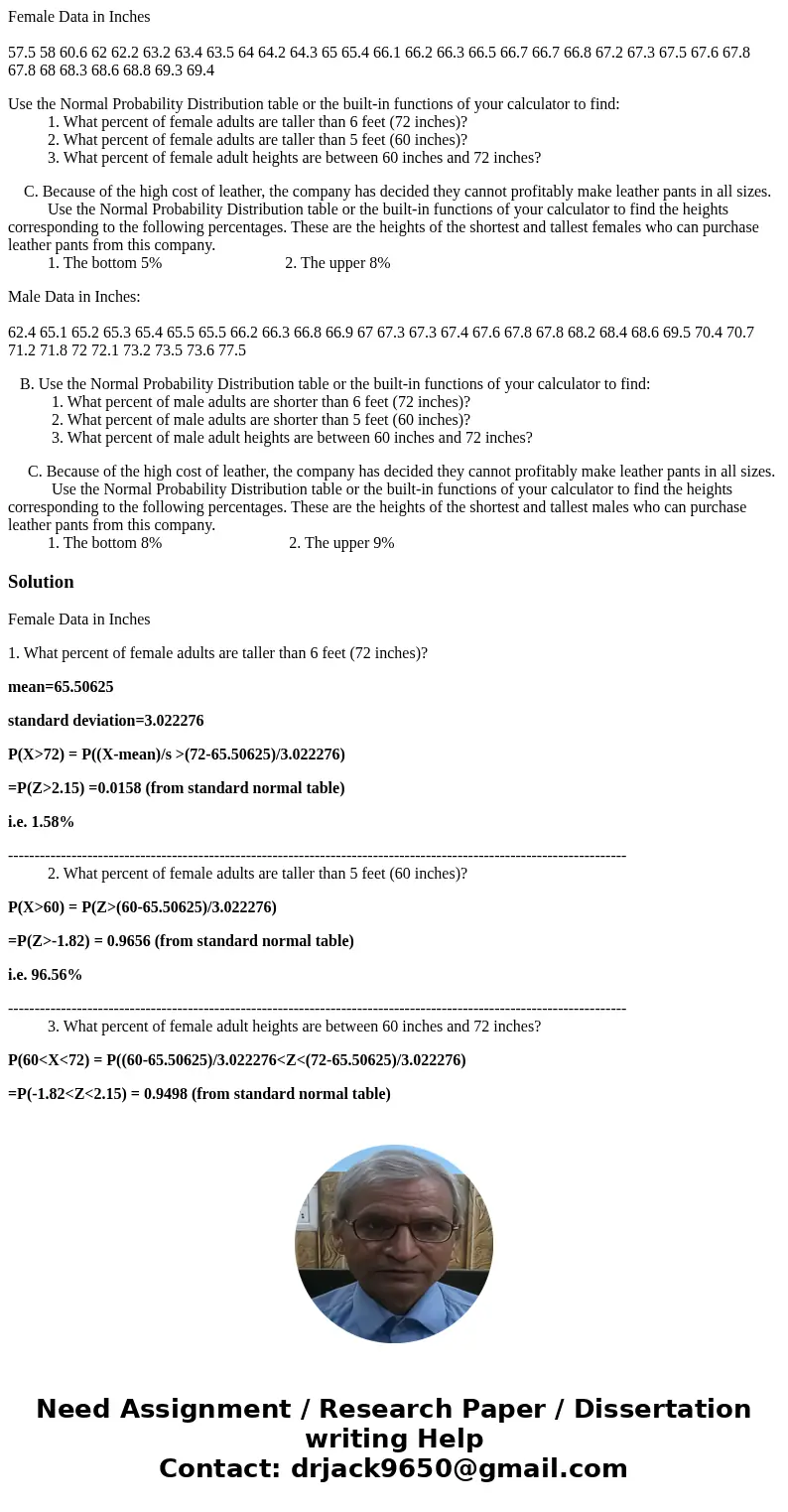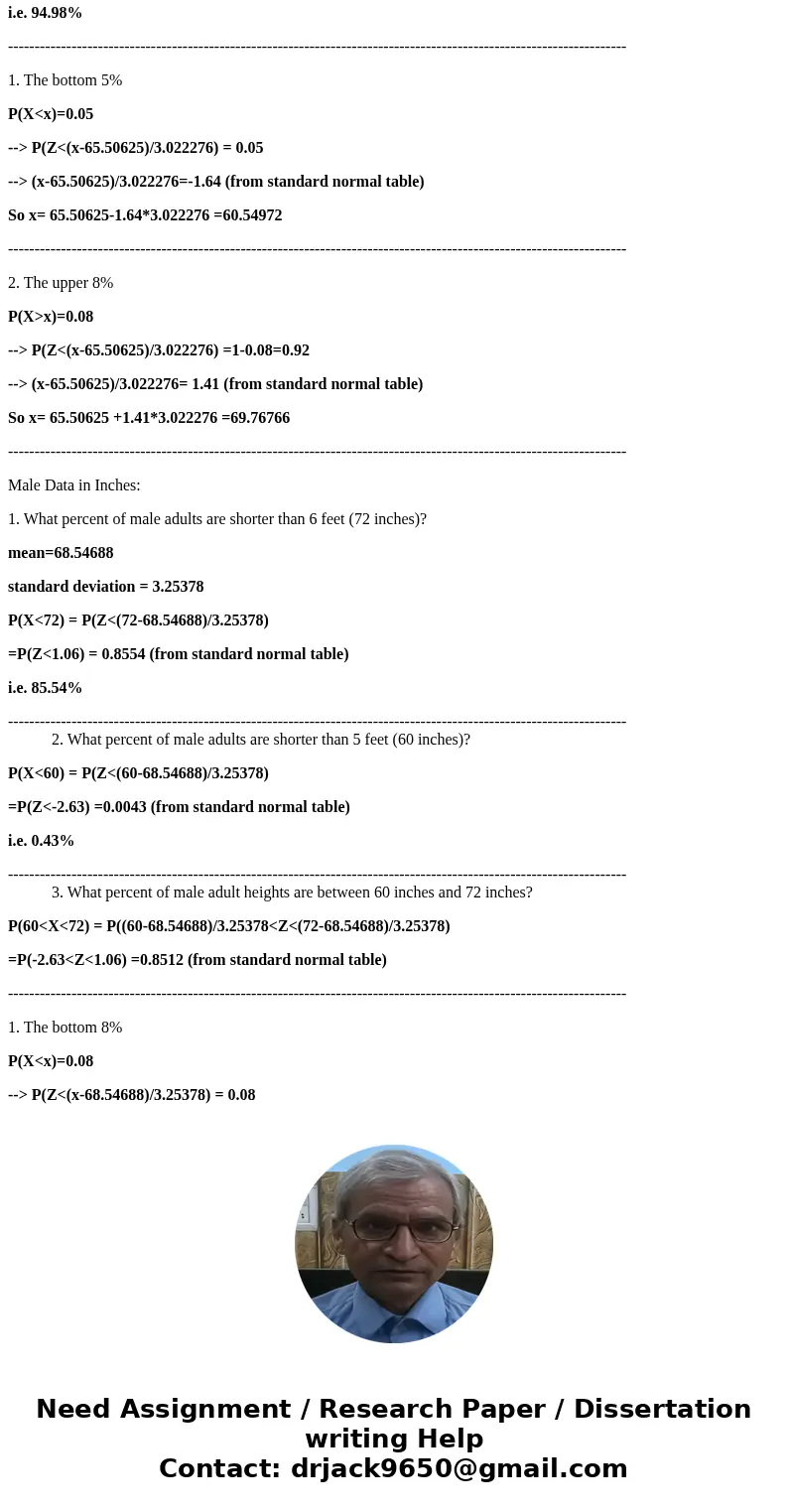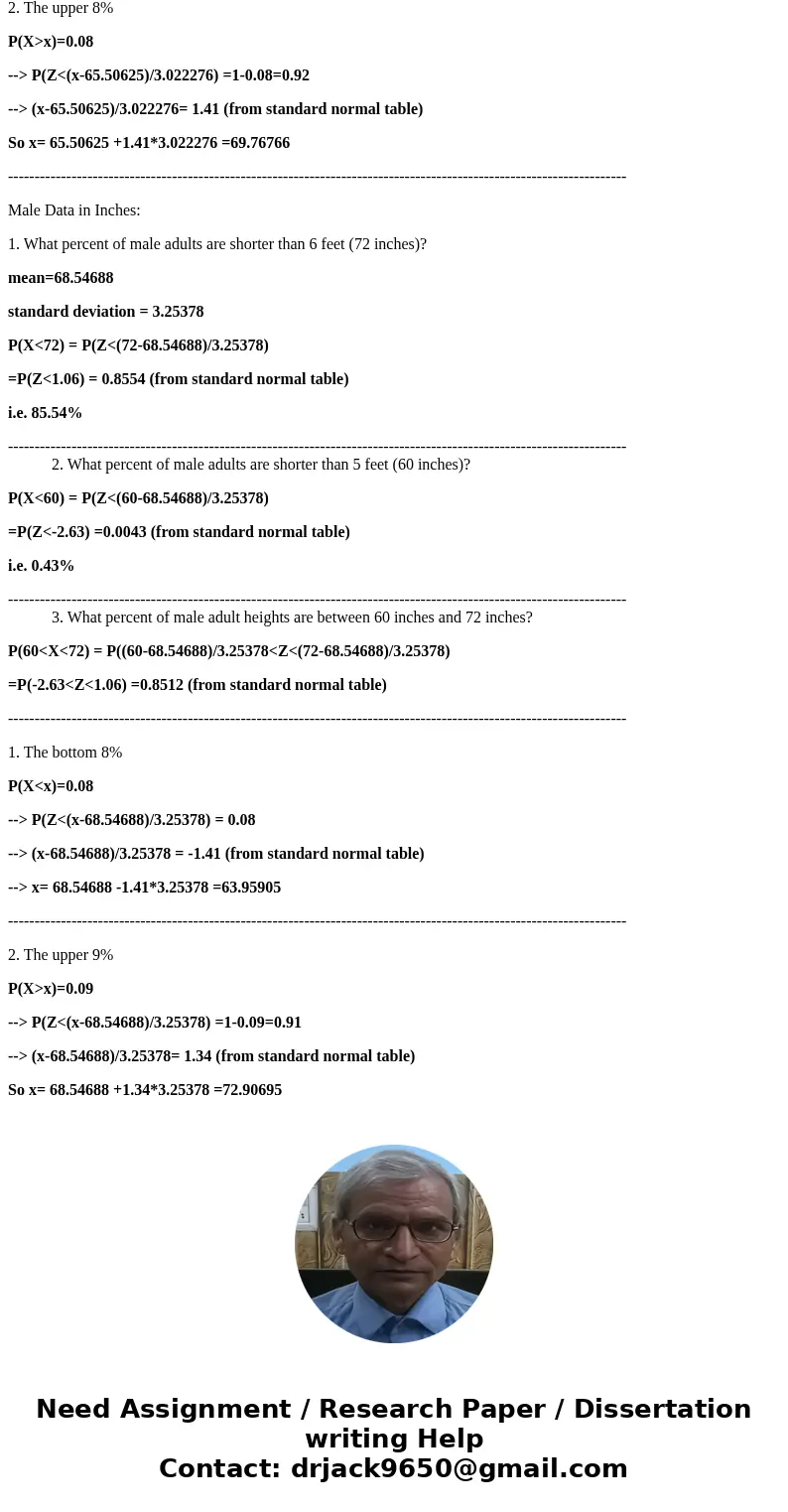Female Data in Inches 575 58 606 62 622 632 634 635 64 642 6
Female Data in Inches
57.5 58 60.6 62 62.2 63.2 63.4 63.5 64 64.2 64.3 65 65.4 66.1 66.2 66.3 66.5 66.7 66.7 66.8 67.2 67.3 67.5 67.6 67.8 67.8 68 68.3 68.6 68.8 69.3 69.4
Use the Normal Probability Distribution table or the built-in functions of your calculator to find:
1. What percent of female adults are taller than 6 feet (72 inches)?
2. What percent of female adults are taller than 5 feet (60 inches)?
3. What percent of female adult heights are between 60 inches and 72 inches?
C. Because of the high cost of leather, the company has decided they cannot profitably make leather pants in all sizes.
Use the Normal Probability Distribution table or the built-in functions of your calculator to find the heights corresponding to the following percentages. These are the heights of the shortest and tallest females who can purchase leather pants from this company.
1. The bottom 5% 2. The upper 8%
Male Data in Inches:
62.4 65.1 65.2 65.3 65.4 65.5 65.5 66.2 66.3 66.8 66.9 67 67.3 67.3 67.4 67.6 67.8 67.8 68.2 68.4 68.6 69.5 70.4 70.7 71.2 71.8 72 72.1 73.2 73.5 73.6 77.5
B. Use the Normal Probability Distribution table or the built-in functions of your calculator to find:
1. What percent of male adults are shorter than 6 feet (72 inches)?
2. What percent of male adults are shorter than 5 feet (60 inches)?
3. What percent of male adult heights are between 60 inches and 72 inches?
C. Because of the high cost of leather, the company has decided they cannot profitably make leather pants in all sizes.
Use the Normal Probability Distribution table or the built-in functions of your calculator to find the heights corresponding to the following percentages. These are the heights of the shortest and tallest males who can purchase leather pants from this company.
1. The bottom 8% 2. The upper 9%
Solution
Female Data in Inches
1. What percent of female adults are taller than 6 feet (72 inches)?
mean=65.50625
standard deviation=3.022276
P(X>72) = P((X-mean)/s >(72-65.50625)/3.022276)
=P(Z>2.15) =0.0158 (from standard normal table)
i.e. 1.58%
---------------------------------------------------------------------------------------------------------------------
2. What percent of female adults are taller than 5 feet (60 inches)?
P(X>60) = P(Z>(60-65.50625)/3.022276)
=P(Z>-1.82) = 0.9656 (from standard normal table)
i.e. 96.56%
---------------------------------------------------------------------------------------------------------------------
3. What percent of female adult heights are between 60 inches and 72 inches?
P(60<X<72) = P((60-65.50625)/3.022276<Z<(72-65.50625)/3.022276)
=P(-1.82<Z<2.15) = 0.9498 (from standard normal table)
i.e. 94.98%
---------------------------------------------------------------------------------------------------------------------
1. The bottom 5%
P(X<x)=0.05
--> P(Z<(x-65.50625)/3.022276) = 0.05
--> (x-65.50625)/3.022276=-1.64 (from standard normal table)
So x= 65.50625-1.64*3.022276 =60.54972
---------------------------------------------------------------------------------------------------------------------
2. The upper 8%
P(X>x)=0.08
--> P(Z<(x-65.50625)/3.022276) =1-0.08=0.92
--> (x-65.50625)/3.022276= 1.41 (from standard normal table)
So x= 65.50625 +1.41*3.022276 =69.76766
---------------------------------------------------------------------------------------------------------------------
Male Data in Inches:
1. What percent of male adults are shorter than 6 feet (72 inches)?
mean=68.54688
standard deviation = 3.25378
P(X<72) = P(Z<(72-68.54688)/3.25378)
=P(Z<1.06) = 0.8554 (from standard normal table)
i.e. 85.54%
---------------------------------------------------------------------------------------------------------------------
2. What percent of male adults are shorter than 5 feet (60 inches)?
P(X<60) = P(Z<(60-68.54688)/3.25378)
=P(Z<-2.63) =0.0043 (from standard normal table)
i.e. 0.43%
---------------------------------------------------------------------------------------------------------------------
3. What percent of male adult heights are between 60 inches and 72 inches?
P(60<X<72) = P((60-68.54688)/3.25378<Z<(72-68.54688)/3.25378)
=P(-2.63<Z<1.06) =0.8512 (from standard normal table)
---------------------------------------------------------------------------------------------------------------------
1. The bottom 8%
P(X<x)=0.08
--> P(Z<(x-68.54688)/3.25378) = 0.08
--> (x-68.54688)/3.25378 = -1.41 (from standard normal table)
--> x= 68.54688 -1.41*3.25378 =63.95905
---------------------------------------------------------------------------------------------------------------------
2. The upper 9%
P(X>x)=0.09
--> P(Z<(x-68.54688)/3.25378) =1-0.09=0.91
--> (x-68.54688)/3.25378= 1.34 (from standard normal table)
So x= 68.54688 +1.34*3.25378 =72.90695



 Homework Sourse
Homework Sourse